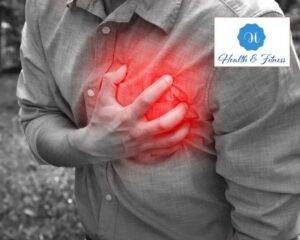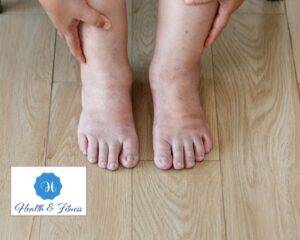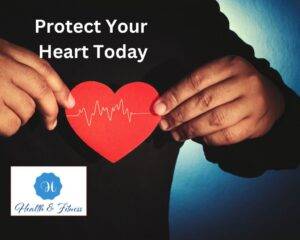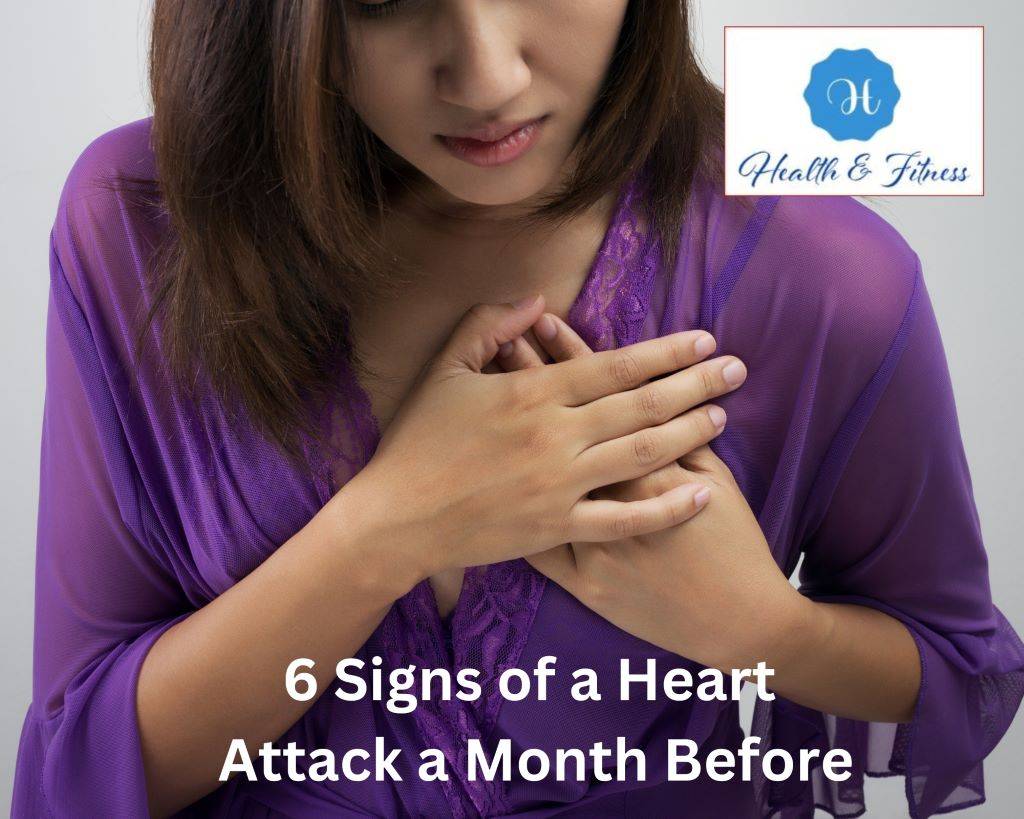6 Signs of a Heart Attack a Month Before: Protect Your Heart Today
6 signs of a heart attack a month before. Discover the critical 6 signs of a heart attack a month before it strikes. Take action to safeguard your heart’s health today.
Introduction to 6 Signs of a Heart Attack a Month Before
Heart attacks are a leading cause of death worldwide and often strike without warning. In many cases, however, there are subtle signs that a heart attack is imminent. Recognizing these early warning signs can be the key to preventing a serious, life-threatening event. In this blog post, we will explore 6 Signs of a Heart Attack a Month Before, which may be just around the corner and offer some practical advice on protecting your heart today.
1- Unusual Fatigue

It is one of the 6 Signs of a Heart Attack a Month Before
Feeling tired now and then is normal, but if you’re experiencing an unusual level of fatigue that doesn’t seem to go away, it could be a warning sign. Some people report feeling exhausted even after doing simple daily tasks in the weeks leading to a heart attack. This is because the heart isn’t effectively pumping blood, so the body isn’t getting the oxygen and nutrients it needs to function correctly.
Take action: Sleep well and eat a balanced diet if you feel exhausted. It’s also a good idea to consult your doctor, who can check for underlying health issues.
2- Difficulty Breathing

Another early sign of a heart attack is being short of breath.
Gasping for air during everyday activities or resting could indicate that your heart can’t pump blood efficiently. This can lead to a buildup of fluid in the lungs, making it difficult to breathe.
Take action: Incorporate regular cardiovascular exercises, such as walking or swimming, into your routine to help improve your heart function. If you’re experiencing shortness of breath, consult your doctor to determine the cause and discuss any necessary treatment.
3- Discomfort or Pain in the Chest

Chest pain or discomfort is among the most common signs of an impending heart attack. You might feel pressure, tightness, or aching in the center of your chest. This pain may come and go, sometimes lasting for just a few minutes or persisting for hours.
Take action: If you’re experiencing chest pain or discomfort, don’t dismiss it as indigestion or heartburn. Seek immediate medical attention, as it could be a sign of a heart attack or another severe heart issue.
4- Feeling dizzy or lightheaded

Feeling dizzy or lightheaded can indicate your heart isn’t pumping enough blood to your brain. This can occur when the heart’s ability to pump blood is compromised, which could mean impending cardiac arrest.
Take action: If you’re experiencing dizziness or lightheadedness, sit down and take a few deep breaths. Drink some water and avoid standing up too quickly. If these symptoms persist, consult your doctor to determine the cause and explore possible treatment options.
5- Cold Sweats and Clammy Skin

Breaking out into a cold sweat and clammy skin can signal your body is stressed. This may be due to the heart working overtime to pump blood, increasing body temperature. Cold sweats and moist skin can also be a symptom of low blood pressure, which can be a precursor to a heart attack.
Take action: If you’re experiencing cold sweats and clammy skin, stay cool by removing layers of clothing or using a fan. Drink plenty of water to stay hydrated, and consult your doctor if these symptoms persist.
6-Swollen Legs, Ankles, or Feet

Swelling in the legs, ankles, or feet can indicate poor blood circulation; this could mean the onset of a heart attack. This swelling, also known as edema, occurs when fluid builds up in the tissues due to the heart’s inability to pump blood effectively.
Take action: Elevate your legs when sitting or lying down to help reduce swelling. Wear compression stockings to help improve blood flow, and consult your doctor for further evaluation and treatment.
What Causes and Risk Factors of Heart Attack?
When understanding heart attacks, it’s essential to know the underlying causes and the risk factors that can increase your chances of experiencing one. Identifying these things helps you safeguard your heart. This section will explore the causes and risk factors associated with heart attacks.
Causes of Heart Attack
After exploring the 6 Signs of a Heart Attack a Month Before, we will discuss the causes of heart attack.
Blocking blood flow to the heart muscle causes a heart attack or myocardial infarction. Plaque in coronary arteries, which provide blood to the heart, causes this obstruction. We mainly caused heart attacks by:
- Coronary Artery Disease (CAD): CAD is the most common cause of heart attacks. Cholesterol and fatty deposits constrict or block coronary arteries, reducing cardiac blood flow.
- Blood Clots: Sometimes, blood clots can form within the narrowed coronary arteries, further obstructing blood flow and leading to a heart attack.
Risk Factors for Heart Attack
Certain variables raise the risk of coronary artery disease and heart attack. We can categorize these risk factors into two types: modifiable and non-modifiable.
Modifiable Risk Factors
- High Blood Pressure (Hypertension): Uncontrolled high blood pressure stresses the heart and raises heart attack risk.
- High LDL Cholesterol (commonly referred to as “bad” cholesterol) and low levels of HDL cholesterol (“good” cholesterol) contribute to plaque buildup and increase the risk of heart disease.
- Smoking: Smoking damages blood vessels, reduces oxygen supply, and accelerates plaque formation in the arteries, significantly raising the risk of heart attack.
- Obesity and Overweight: Excess body weight, especially around the waist, increases cardiovascular stress and the likelihood of cardiovascular disease.
- diabetes: People with diabetes have a higher risk of heart disease, primarily because of contributors like being overweight or having hypertension or high cholesterol.
- Sedentary Lifestyle: High blood pressure, cholesterol, obesity, and diabetes are heart disease risk factors caused by inactivity.
Non-Modifiable Risk Factors
- Age: The risk of heart attack increases with age. Men aged 45 and older and women aged 55 and older are at higher risk.
- Gender: Premenopausal women have fewer heart attacks than males. Women’s risk rises after menopause.
.3. Family History: A family history of heart disease or heart attacks can increase the likelihood of developing cardiovascular problems.
4. Ethnicity: Certain ethnicities, such as African Americans, Hispanics, and South Asians, have a higher risk of heart disease.
5. Previous Heart Attack or stroke: A history of a heart attack or stroke increases the risk of future cardiac events.
What do I do if I feel like I’m having a heart attack?
If you or someone else is experiencing heart attack symptoms, it’s crucial to act immediately. Here are the steps you should take:
- Call Emergency Services: Dial 911. Please do not ignore the symptoms or try to tough it out. The sooner you get to an emergency room, the better your chances of survival and less damage to your heart.
2. Chew and Swallow an Aspirin: Aspirin can help prevent further blood clotting. If you’re allergic or your doctor says not to take aspirin, don’t.
3. Take Nitroglycerin, if Prescribed: If you have been prescribed nitroglycerin tablets or spray for angina, take it as directed while awaiting emergency help.
4. If unconscious, start CPR: Start CPR on a cold heart attack suspect. Doctors prescribe chest compressions (100–120 per minute) if you don’t know CPR. The dispatcher may guide you until aid comes.
Remember, heart attack symptoms vary. Not everyone who has a heart attack experiences the classic symptoms. If you’re unsure, have it checked out; it’s better to be safe than sorry.
Protect Your Heart Today and reduce the risk of a heart attack.

Reducing the risk of a heart attack involves managing known risk factors and leading a healthy lifestyle. Here are some strategies:
- Quit Smoking: If you smoke, quit. If you don’t smoke, don’t start. Smoking is a significant risk factor for heart disease.
- Control Blood Pressure: High blood pressure can damage your arteries, leading to a heart attack. Regular check-ups, a healthy diet, exercise, and medication (if your doctor prescribes it) can help control your blood pressure.
- Check Cholesterol and Triglyceride Levels: High levels can increase the risk of heart disease. A healthy diet and regular exercise can help lower these levels, and medication may sometimes be necessary.
- Control Diabetes: If you have diabetes, tight blood sugar control can help reduce the risk of a heart attack.
- Get Regular Exercise: Regular exercise helps improve heart muscle function, maintains a healthy weight, and can help control blood pressure, cholesterol levels, and diabetes.
- Eat a Heart-Healthy Diet: Include fruits, vegetables, whole grains, lean proteins, and healthy fats. Limit salt, saturated fats, sweets, and red meats.
- Maintain a Healthy Weight: Being overweight or obese increases your risk of heart disease. A healthy diet and regular exercise can help you achieve and maintain a healthy weight.
- Manage Stress: Find healthy ways to cope with stress, such as relaxation exercises, meditation, or yoga.
- Limit Alcohol: Excessive alcohol can raise blood pressure and add extra calories, leading to weight gain. Men should aim for no more than two drinks per day, and women should aim for no more than one.
- Regular Check-ups: Regular health check-ups can help detect problems before they become serious.
Remember, it’s essential to consult with a healthcare provider before starting any new exercise or diet regimen. They can provide guidance based on your current health status and medical history.
Conclusion about 6 Signs of a Heart Attack a Month Before
Protecting your heart should be a top priority, and being aware of the 6 Signs of a Heart Attack a Month Before it occurs empowers you to take action. You can proactively protect your heart’s health by recognizing the signs of crushing chest pain, unexplained fatigue, shortness of breath, unusual sweating, jaw and neck discomfort, and listening to your intuition. Remember, early detection and intervention can make a difference in preventing a life-threatening event and living a healthier life. Start taking steps today to prioritize your heart health and ensure a brighter future.
Reference
American Heart Association. (2021). Warning Signs of a Heart Attack. Retrieved from https://www.heart.org/en/health-topics/heart-attack/warning-signs-of-a-heart-attack
National Heart, Lung, and Blood Institute. (2021). Heart Attack. Retrieved from https://www.nhlbi.nih.gov/health-topics/heart-attack
You may be interested in



